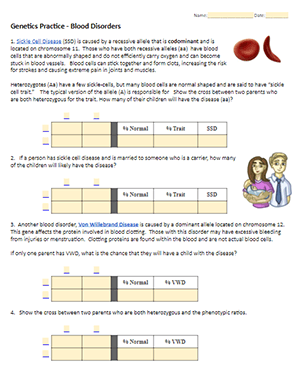
I created this worksheet for anatomy students to practice using Punnett squares and comparing different types of mutations that affect the blood.
Ideally, students will have already learned about genetics of blood types. Because I use this worksheet in my anatomy class, I don’t spend a lot of time teaching genetics. However, students do need a refresher, and it aligns well with the unit on blood.
The lesson explores sickle cell disease as a codominant trait caused by a mutation in the gene that codes for hemoglobin. Individuals who receive two alleles have the disorders, carriers only have one allele. I designed the worksheet to be completed on their Chromebooks. Highlighted regions in the document indicate spaces where students need to fill in their work.
Students then examine Von Willebrand Disease hemophilia as a sex linked disorder. They practice making predictions with Punnett squares. A short description and a link explains that a mutation occurs in proteins responsible for blood clotting. Hemophilia is sex-linked and VWD is associated with a gene on chromosome 12.
Finally, students explore beta thalassemia which is similar to sickle cell disease. A mutation of the HBB gene changes the shape of blood cells and their efficiency.
The goal of this worksheet is not only to practice making predictions and using Punnett squares but to also show the link between chromosome mutations and human disease.
The final question asks students to determine which disorders are most similar and what they all have in common.

